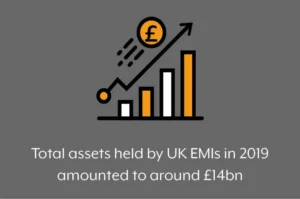Jon Wedge
Financial Services, Partner at BKL
EMIs are an exciting subsector to be involved with. Their combination of innovation and convenience appeals to entrepreneurs and customers alike, fuelling rapid development worldwide but especially in the UK.
Where there are growth opportunities for EMIs, there are also challenges. The FCA’s changing approach to regulation brings specific risks for EMIs in the UK. The better you understand the application process for e-money licences, the less likely you are to make costly mistakes. The impact of Brexit is a consideration too.
If you’d like to explore how these developments could affect your EMI business, you’ll find insights in this report from us and other fintech experts to help you keep your ambitions on track.
EMIs HAVE BEEN A BOOM SECTOR – BUT IS THERE TROUBLE AHEAD?
Electronic money services are one of the fastest-growing financial services subsectors. Driving this are rapid innovation in fintech, the acceleration of cashless payments, and growing demand for payment services from small entrepreneurial businesses, a traditionally underbanked section of the market.
E-money licences, issued by the Financial Conduct Authority (FCA) in the UK, allow electronic money institutions (EMIs) to offer a huge range of e-money services. These licences have become an attractive option for fintech innovators, as they are more flexible and less rigidly regulated than banking licences, and the application process is relatively quick and straightforward.

The attraction for customers is clear. Accounts can be opened quickly, online and with the minimum amount of paperwork, offering flexibility and convenience. EMIs cannot provide loans or interest-accumulating accounts but have introduced a wide range of payment and other financial solutions to their customers, from quick and easy international money transfers to prepaid payment cards.

The epicentre for activity in Europe has been London. It has gained a reputation for being one of the most attractive jurisdictions in which to set up an EMI, as a result of:
- A relatively stable financial and legislative environment
- A well-respected regulator in the FCA
- A relatively mature payments sector
- Its reputation as a hub for fintech innovators, with strong R&D investment and a workforce with leading tech and financial skills
As of 25 May, 235 EMIs have been set up in the UK compared with 244 in the rest of Europe combined. Total assets held by UK EMIs in 2019 amounted to around £14bn.
But there are clouds on the horizon. The prospect of tighter regulation around EMIs, along with the impact of Brexit, brings specific risks for EMIs in the UK.
FCA TIGHTENS ITS GRIP
EMIs operate in an environment of lighter regulation and supervision than more traditional FS providers. Authorised EMIs are subject to capital requirements: they must hold initial capital of €350,000 and must meet the FCA’s conduct of business rules and
safeguarding requirements.
‘Small EMI’ licenses are also available for EMIs with annual payment transactions of less than €3m, which operate exclusively within the UK. Around 30 of these have been issued so far.
But there are clear signs that as the EMI sector grows, the FCA and other regulators are stepping up their scrutiny of institutions and enforcement of regulations. E-money licences are increasingly being used by a wide variety of businesses, from global giants such as Airbnb and Google to startups. More and more money is at stake; the risk of consumers being confused by companies that to all intents and purposes look like a bank, but which don’t have a banking licence and which don’t offer the same level of protection as regulated banks, is increasing every year.
The collapse of Wirecard, which filed for insolvency in Germany in the summer of 2020, has also drawn regulators’ and governments’ attention to the sector. Wirecard announced in June that €1.9bn in cash was missing from its accounts; its former chief executive is under investigation and the scandal triggered an examination of Germany’s system of financial regulation after BaFin brushed aside early warnings of possible fraud.

In April 2020, the FCA’s 2020/21 Business Plan announced payment services as a priority area. Three months later, the FCA wrote an open letter to the CEOs of payment services firms and EMIs setting out the steps it expects them to take to meet their regulatory obligations in six areas:
- Safeguarding customers’ funds – from December 2020 to January 2021, the UK Government ran a consultation that asked for views on the introduction of a new administration regime for payment providers and EMIs. The regime is intended to protect customers should an EMI fall into insolvency, given that EMIs are not part of the Financial Services Compensation Scheme.
- Prudential risk management – the FCA said it expects firms to have acted to review and remediate this in light of additional guidance issued by the FCA.
- Financial crime – the FCA will ‘continue to undertake targeted assessments and will take action against firms that fall short of our expectations’.
- Customer communications and promotions – the FCA stressed that these should be clear, fair and not misleading.
- Governance and oversight – the FCA identified inadequate governance and oversight as ‘a root cause of many … EMIs’ regulatory issues’.
- Reporting and records management
Anecdotal evidence reinforces the view that the FCA is tightening its grip around EMIs: we have seen the FCA ask questions of EMI clients that would normally be asked of a bank. It’s clear that both regulation and enforcement will inevitably become more stringent in the coming years.
THE IMPACT OF BREXIT
UK financial institutions lost their right to serve European customers through their EEA passporting rights on 1 January 2021. It is thought that around half of the UK’s EMIs could be affected by Brexit, based on the number that appear on the European Banking Authority’s central register.
The full impact of Brexit is still unclear as the financial services sector did not form part of the trade agreement signed between the UK and the European Commission in December 2020. A draft UK-EU Memorandum of Understanding on financial services was agreed in March this year, but is limited and focuses mainly on the mechanism for future discussions on regulation and equivalence.
Given the FCA’s increasing interest in EMIs, it also seems unlikely that the sector will benefit from the government’s Taskforce on Innovation, Growth and Regulatory Reform (TIGRR), which will look at ways of reducing post-Brexit red tape.
Most EMIs were well prepared for the changes and have been taking steps to offset the risk of losing their passporting rights. A number of EMIs have already set up subsidiaries in the EU, or formed joint ventures with EU EMIs, to handle EU-based customers; those EMIs with relatively few EU customers have stopped offering services beyond the UK’s borders.
For those setting up subsidiaries outside the UK, Lithuania has proved the most popular option. It was already the second most popular location for EMIs in Europe, after the UK: it offers a fast and transparent application process for licensing EMIs (more than 100 licenses have been issued in the past two years) and has strong fintech credentials. Revolut, Curve and Yapily have all set up operations in Lithuania in recent months.
Next: our top tips for EMIs with plans to expand into other European countries.
FIVE TIPS FOR EMIs EXPANDING IN EUROPE
There are risks for EMIs thinking of setting up operations or a subsidiary in Europe. Local regulations will apply and need to be carefully assessed, and the corporate structure for UK businesses will inevitably be complicated. So what can EMIs do to prepare?
- Ask for specialist support during the e-money licence application process
The FCA is asking increasingly complex questions of organisations applying for an e-money licence, including requesting ‘reverse stress-testing’ of forecasts. Applicants need to be as prepared as possible, and able to show that they have thoroughly tested their business plan. - Assess whether you need to rethink your structure post-Brexit
EMIs based in London with business or potential business in the rest of Europe – and vice versa – may need to establish a legal presence in order to reach the maximum number of customers. - Take full advantage of available incentives
Attractive R&D tax credit opportunities are available to innovative companies setting up in the UK. - Don’t get caught out on VAT
VAT can be particularly complex for EMIs that qualify and the penalties for getting it wrong can be severe. Don’t assume it won’t affect your business. - Keep ahead of developments
It is likely that the FCA will continue to tighten its scrutiny of EMIs in the future. Forewarned is forearmed, so keep track of developments through the FCA website and your own adviser.
E-MONEY LICENCE APPLICATIONS: TAKE CARE WITH THE COMPLEXITIES
You’ve just read about being prepared prior to applying for an e-money licence from the FCA. As experts in corporate compliance and financial services regulation, we’d like to explore some of these areas in more detail.
Safeguarding requirements
Meeting the FCA’s safeguarding requirements is critical. The FCA takes a very close look at what is proposed by the applicant as to:
- The flow of fiat money through your firm
- Whether the technology precisely follows that proposed flow
- Whether the fiat flow and technology are robust and compliant with the rules
- How the systems put in place will ensure that the client funds in the safeguarding accounts mirror exactly the electronic money in issuance
With various factors to consider – different transaction models; delivering payments, cards and services to a client via more than one technology and service provider – the flow may be more complicated than it first seems. But if you cannot describe, demonstrate and evidence all of this in a simple way to the case officer at the FCA, your application will not be off to a good start.
It is key to your application, prior to translating your funds flows from theory to practice, to ensure that each step of the process is compliant with the client funds’ safeguarding obligations. The overall picture can be further complicated should your firm also desire to offer additional services such as rewards, crypto or even access to securities and lending etc. It is sensible to work with the card issuer and safeguarding auditor at this juncture to make sure that the application process is as seamless as possible.
Care of client funds
Having built your business model, one area of complexity revolves around the safeguarding of your clients’ monies. You will need to consider the actual movement of those monies within the firm, and between the firm and its FX provider, card provider, corporate bank account and safeguarded bank accounts (as and where applicable). All this requires careful thought and a combination of technology and human involvement to ensure that it operates correctly.
We have seen the errors of firms which have built their processes without referring to the FCA rules, meaning that every regulated payment made was in breach of the safeguarding rules. Unwinding that process and rebuilding the technology and procedures whilst under the watchful eye of the regulator is much costlier than building it properly in the first place.
One cautionary tale involves a major UK bank that provided FX liquidity and the payment rails to its EMI/PSD (Payment Services Directive) clients. The bank encouraged those clients to skip the safeguarding step in the transaction flow because it saved the bank additional processing. It led to around 80 firms breaching. Some of those clients ignored the rules, some didn’t understand the rules, but others changed. It didn’t take long for the FCA to find out.
Virtual accounts, real money
E-money firms do advertise themselves as providing “bank accounts” which is what their clients understand they have, but they are actually virtual accounts. Semantics aside, the big difference is that the compensation that covers all those safeguarded accounts held at EMIs is limited to £50,000 – and that is just the figure that compensates the e-money firm in case of failure of its banking partner. In other words, it covers the gross balance of all their clients’ monies that are in the safeguarded account at that time, even though the account could potentially contain millions! It’s critical to ensure that all funds that sit in the virtual bank accounts are captured by a virtual IBAN.
Proper auditing of safeguarded accounts, and of the governance structure supporting them, requires a level of skill and knowledge that very few auditors possess. We strongly recommend being thorough in your due diligence before appointing an auditor.
Planning for wind-down
And that brings us to the wind-down plan that is becoming a requirement of all new applicants (and incumbents). This takes the form of a document – again, not a simple one – whose purpose is to enable an orderly wind-down and to show that your firm can pay for it if and when necessary.
In the past, safeguarded monies have contributed to the costs of winding down. That was never the intent of the regulations which seek to ensure that clients’ regulated monies are protected and, in theory, returned to them quickly in the event of failure. History has shown this hasn’t worked, hence the new requirement.
If you have any questions please contact Nick Andrews on [email protected] or call +44 (0)20 3056 0956.


